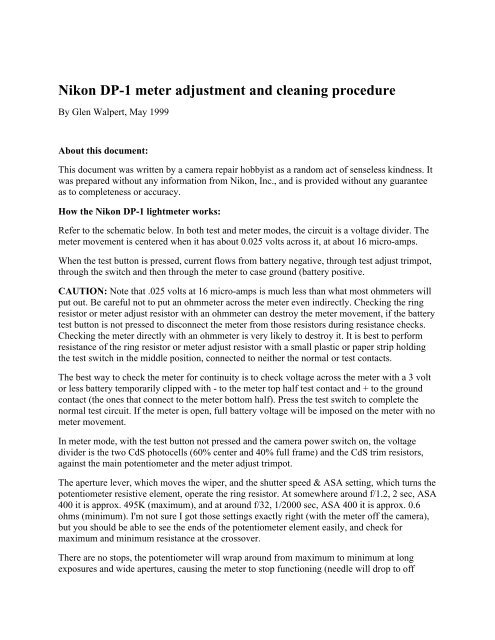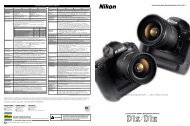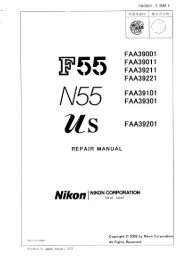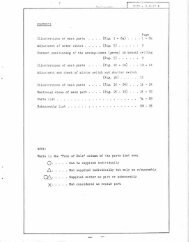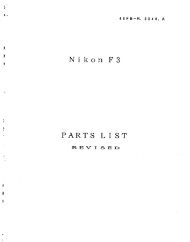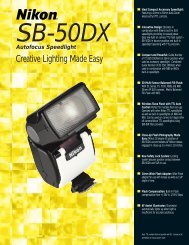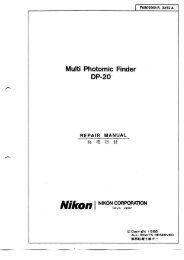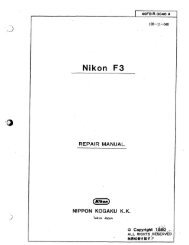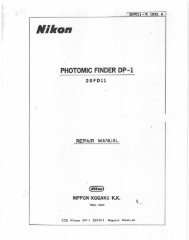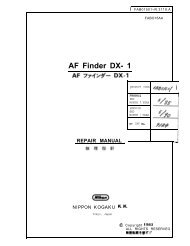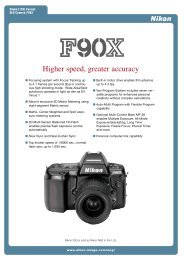Nikon DP-1 meter adjustment and cleaning procedure
Nikon DP-1 meter adjustment and cleaning procedure
Nikon DP-1 meter adjustment and cleaning procedure
You also want an ePaper? Increase the reach of your titles
YUMPU automatically turns print PDFs into web optimized ePapers that Google loves.
<strong>Nikon</strong> <strong>DP</strong>-1 <strong>meter</strong> <strong>adjustment</strong> <strong>and</strong> <strong>cleaning</strong> <strong>procedure</strong><br />
By Glen Walpert, May 1999<br />
About this document:<br />
This document was written by a camera repair hobbyist as a r<strong>and</strong>om act of senseless kindness. It<br />
was prepared without any information from <strong>Nikon</strong>, Inc., <strong>and</strong> is provided without any guarantee<br />
as to completeness or accuracy.<br />
How the <strong>Nikon</strong> <strong>DP</strong>-1 light<strong>meter</strong> works:<br />
Refer to the schematic below. In both test <strong>and</strong> <strong>meter</strong> modes, the circuit is a voltage divider. The<br />
<strong>meter</strong> movement is centered when it has about 0.025 volts across it, at about 16 micro-amps.<br />
When the test button is pressed, current flows from battery negative, through test adjust trimpot,<br />
through the switch <strong>and</strong> then through the <strong>meter</strong> to case ground (battery positive.<br />
CAUTION: Note that .025 volts at 16 micro-amps is much less than what most ohm<strong>meter</strong>s will<br />
put out. Be careful not to put an ohm<strong>meter</strong> across the <strong>meter</strong> even indirectly. Checking the ring<br />
resistor or <strong>meter</strong> adjust resistor with an ohm<strong>meter</strong> can destroy the <strong>meter</strong> movement, if the battery<br />
test button is not pressed to disconnect the <strong>meter</strong> from those resistors during resistance checks.<br />
Checking the <strong>meter</strong> directly with an ohm<strong>meter</strong> is very likely to destroy it. It is best to perform<br />
resistance of the ring resistor or <strong>meter</strong> adjust resistor with a small plastic or paper strip holding<br />
the test switch in the middle position, connected to neither the normal or test contacts.<br />
The best way to check the <strong>meter</strong> for continuity is to check voltage across the <strong>meter</strong> with a 3 volt<br />
or less battery temporarily clipped with - to the <strong>meter</strong> top half test contact <strong>and</strong> + to the ground<br />
contact (the ones that connect to the <strong>meter</strong> bottom half). Press the test switch to complete the<br />
normal test circuit. If the <strong>meter</strong> is open, full battery voltage will be imposed on the <strong>meter</strong> with no<br />
<strong>meter</strong> movement.<br />
In <strong>meter</strong> mode, with the test button not pressed <strong>and</strong> the camera power switch on, the voltage<br />
divider is the two CdS photocells (60% center <strong>and</strong> 40% full frame) <strong>and</strong> the CdS trim resistors,<br />
against the main potentio<strong>meter</strong> <strong>and</strong> the <strong>meter</strong> adjust trimpot.<br />
The aperture lever, which moves the wiper, <strong>and</strong> the shutter speed & ASA setting, which turns the<br />
potentio<strong>meter</strong> resistive element, operate the ring resistor. At somewhere around f/1.2, 2 sec, ASA<br />
400 it is approx. 495K (maximum), <strong>and</strong> at around f/32, 1/2000 sec, ASA 400 it is approx. 0.6<br />
ohms (minimum). I'm not sure I got those settings exactly right (with the <strong>meter</strong> off the camera),<br />
but you should be able to see the ends of the potentio<strong>meter</strong> element easily, <strong>and</strong> check for<br />
maximum <strong>and</strong> minimum resistance at the crossover.<br />
There are no stops, the potentio<strong>meter</strong> will wrap around from maximum to minimum at long<br />
exposures <strong>and</strong> wide apertures, causing the <strong>meter</strong> to stop functioning (needle will drop to off
position).<br />
The photocell resistance (both cells) varies from over 4 million ohms in a fairly dark room to less<br />
than 200 ohms when the <strong>meter</strong> is held about 6 inches from a 60-watt bulb.<br />
The above measurements are from a single working <strong>meter</strong>. Small variance can be expected from<br />
<strong>meter</strong> to <strong>meter</strong>.<br />
<strong>Nikon</strong> <strong>DP</strong>-1 Meter Schematic<br />
Troubleshooting:<br />
Check your batteries, they should be about 1.5 volts each, <strong>and</strong> you should have -3 volts on the<br />
<strong>meter</strong> power contacts at the top of the camera body when the film advance lever is pulled out to<br />
the on position.<br />
Meter completely dead - this could be an open circuit anywhere, including the <strong>meter</strong> movement.<br />
Check the entire circuit.<br />
Test function works but <strong>meter</strong> reads erratically or not at all - bad contact on main potentio<strong>meter</strong><br />
or poor connection; disassemble, inspect <strong>and</strong> clean.<br />
Adjustment (<strong>meter</strong> on camera):<br />
Peel off the leather <strong>meter</strong> cover <strong>and</strong> remove the small oval metal plate covering the <strong>adjustment</strong>s.<br />
Two trim potentio<strong>meter</strong>s will be accessible, the left trim is for <strong>meter</strong> test <strong>and</strong> the right trim is for<br />
<strong>meter</strong> sensitivity. The <strong>adjustment</strong>s are independent <strong>and</strong> can be done in any order.<br />
(Note: It is not necessary to remove the leather cover to disassemble <strong>and</strong> clean the <strong>DP</strong>-1.)
Fig. 1 - <strong>DP</strong>-1 <strong>adjustment</strong> locations<br />
Adjustment should be done with fresh batteries.<br />
Set the <strong>meter</strong> test trim so that the needle is centered when the test button is pressed.<br />
Focus the camera (full frame) on an evenly illuminated 18% gray card, <strong>and</strong> adjust the sensitivity<br />
to agree with a known accurate <strong>meter</strong>. If you don't have a known accurate <strong>meter</strong>, you can make<br />
an approximate setting by using film manufacturers recommended setting for direct sunlight. For<br />
example, set the camera to ASA 100, 1/125 sec, f/16, <strong>and</strong> adjust the <strong>meter</strong> to center the needle<br />
when aimed at a gray card in direct sunlight. You could then make fine <strong>adjustment</strong>s based on test<br />
shots, for example, if tests indicate you need 1/2 stop more exposure, set up with the gray card,<br />
center the needle, open up 1/2 stop, <strong>and</strong> re-center the <strong>meter</strong> using the sensitivity trim <strong>adjustment</strong>.<br />
The two CdS trimpots are only accessible with the <strong>meter</strong> disassembled. These trimpots should<br />
only need <strong>adjustment</strong> if the CdS cells are replaced, <strong>and</strong> the <strong>adjustment</strong> would normally be done<br />
with a calibrated light box. If you check the <strong>meter</strong> sensitivity over it's full range, <strong>and</strong> find that the<br />
<strong>meter</strong> is off at the ends after adjusting the main sensitivity <strong>adjustment</strong> to be correct in the middle,<br />
it should be possible to trim the dark or bright sensitivity with a trial-<strong>and</strong>-error <strong>procedure</strong>.<br />
Decreasing the resistance of either trim will increase the <strong>meter</strong> sensitivity at that end.<br />
If <strong>meter</strong> cannot be adjusted, disassemble, clean <strong>and</strong> inspect.
Fig. 2 - <strong>DP</strong>-1 bottom view<br />
Fig. 3 - <strong>DP</strong>-1 split - interior view<br />
Disassembly:<br />
With <strong>meter</strong> removed from camera <strong>and</strong> turned upside down, remove the 4 light baffle screws,<br />
retainer plates, <strong>and</strong> rubber light baffles. Do not loose the 4 steel spacers that fit in the baffles <strong>and</strong><br />
prevent the screws from crushing the rubber. Separate the two <strong>meter</strong> halves.
Press in the lens aperture lug to release the aperture mechanism, positioning the brush assembly<br />
as shown in Fig. 3, <strong>and</strong> allow the shutter speed to go to 1/2000 (spring-loaded position). Scribe<br />
small alignment marks on the white plastic aperture gear, the brush holder ring, <strong>and</strong> the ring<br />
resistor, so that they can be returned to the exact same position. (Scribing with a diamond or<br />
carbide scriber is preferable to a marking pen or paint, which might wash off during <strong>cleaning</strong>.)<br />
Remove the brush holder, being careful not to bend the brushes.<br />
Remove the ground contact <strong>and</strong> the speed indicator pulley. It is not necessary to remove the<br />
string from the speed indicator pulley, but it is necessary to remove both the clip <strong>and</strong> washer<br />
before the pulley will remove easily.<br />
Fig. 4 - <strong>DP</strong>-1 ring resistor removal<br />
Remove the Front Roller (see figures 3 <strong>and</strong> 4) <strong>and</strong> the rear Roller Assembly, which guide the<br />
brush carrier <strong>and</strong> ring resistor.<br />
Lift out the Brush Carrier ring <strong>and</strong> the Ring Resistor, to reveal the Ring Resistor Ground Brush<br />
under the ring resistor. This brush was the problem in this particular <strong>meter</strong> <strong>and</strong> it is probably a<br />
common problem in <strong>DP</strong>-1's in general. Examination under a microscope or strong magnifier<br />
revealed that the ground brush was only making contact on the inner corner, due to the angle it<br />
was bent to at the factory. The gold plating had worn away from this corner, <strong>and</strong> the base metal<br />
underneath had corroded, producing a poor, intermittent contact. Specks of gold plating could be<br />
seen rubbed off on the ring resistor bottom surface, which had an excessively rough surface for<br />
its intended function as a sliding electrical contact (compare to the finish on the Inner Brush<br />
Contact).<br />
The solution to the ground brush contact problem is to bend the ground contact so that a new<br />
section with intact gold plating makes contact with the ring resistor. Twist the contact so that it is<br />
nearly flat <strong>and</strong> both halves of the split section make contact with the ring resistor.<br />
Polish the contact surface of the ring resistor slightly to remove all traces of transferred gold,
eing careful not to wear through the thin nickel plating of the brass ring resistor. Rubbing<br />
lightly on 600 grit or finer s<strong>and</strong>paper will do, <strong>and</strong>/or polish with jewelers rouge on a piece of<br />
paper or cloth on a flat surface. Clean off all abrasive residues, then burnish by rubbing on plain<br />
dry paper on a flat surface. The better the polish, the longer the re-bent ground contact will last;<br />
however polishing through the nickel plating will ruin the ring resistor, so do not attempt to<br />
remove all of the factory scratch marks; just smooth them out a bit.<br />
Cleaning:<br />
Clean all parts with tape head cleaner, alcohol, or a non-residue electronic parts cleaner, using<br />
lintless swabs or wipers. Be very careful of the delicate ring resistor element. Do not use any<br />
lubricant on electrical contacts; it will attract dust <strong>and</strong> cause wear. Do not use any spray cleaner,<br />
especially on the bottom half, there is risk of getting cleaner <strong>and</strong> dirt on optical surfaces which<br />
are difficult to access.<br />
Reassemble the <strong>meter</strong> in the reverse order of disassembly, starting with the ring resistor, brush<br />
carrier <strong>and</strong> guide rollers. Apply a tiny bit of oil to the inside only of the ring resistor guide<br />
rollers, <strong>and</strong> adjust the roller assembly position for smooth operation with no play. A light sewing<br />
machine oil is good, it can be applied sparingly at the edge of the roller mounting screw head,<br />
using a flattened wire dipped in oil, after roller assembly.<br />
Set the shutter speed indicator pulley on its shaft <strong>and</strong> rotate the indicator by grabbing the shaft<br />
below the pulley with tweezers <strong>and</strong> rotating it counter-clockwise. Hold the partially rotated<br />
indicator in position with light pressure on the top of the pulley, while shifting grip with the<br />
tweezers, until it is rotated to the 1/2000 position, where the alignment pin will drop into the hole<br />
in the pulley. Replace the washer <strong>and</strong> clip.<br />
Verify that the ring resistor operates smoothly over its full range, <strong>and</strong> that it's resistance varies<br />
continuously from maximum to minimum with no jumpiness or irregularities. Be sure the <strong>meter</strong><br />
movement is disconnected while measuring resistance, with a paper strip holding the test switch<br />
contact open. If all checks out, complete reassembly <strong>and</strong> check <strong>adjustment</strong>.
Fig. 5 - <strong>DP</strong>-1 ring resistor brush


